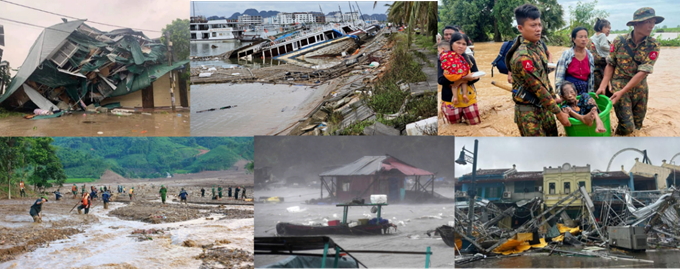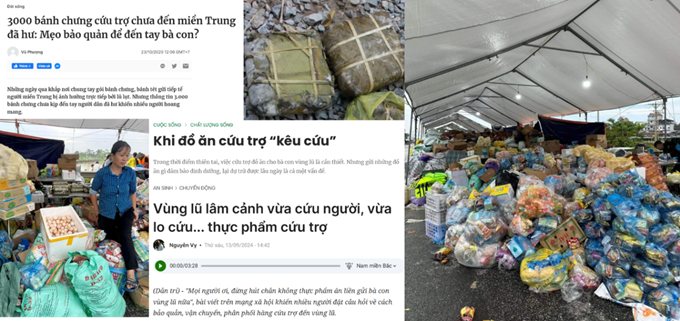1. The rising frequency of disasters and the urgent need for effective relief food
In recent years, the world has faced an increasing frequency and severity of natural disasters such as super typhoons, flash floods, landslides, earthquakes, and volcanic eruptions. In 2024 alone, many devastating events occurred worldwide: Super Typhoon Yagi (known as Typhoon No. 3 in Vietnam), with winds reaching Category 16 and gusts over Category 17, severely impacted countries surrounding the East Sea, including China, Myanmar, Vietnam, and the Philippines; South Korea experienced record snowfall; Hawaii’s Kīlauea volcano erupted unexpectedly; flash floods struck Afghanistan; and major storms battered the U.S. and Taiwan.
Vietnam, too, was not spared. In 2024, the country recorded 39 flash floods and severe landslides across 32 provinces in the Northern, Central, and Central Highlands regions. These disasters resulted in over 500 deaths and missing persons, more than 2,000 injuries, and economic losses nearing VND 89 trillion – 9.52 times higher than 2023 and 4.19 times the 10-year average (2014-2023). The East Sea experienced 10 storms and 1 tropical depression that year.

Severe damages caused by Super Typhoon Yagi in Southeast Asian countries.
In this context, ensuring access to safe, nutritious, and easy-to-use food for disaster-affected populations is critically important. However, traditional relief foods (e.g., bread, sticky rice cakes, instant noodles, rice balls) present many limitations – complicated preparation, spoilage risks in harsh conditions, low nutritional value, and unsuitability for vulnerable groups like the elderly, children, or those with chronic health conditions.

Relief food overload and spoilage at a disaster site due to poor storage.
2. What is Disaster-Preparedness Food?
Unlike conventional relief food, disaster-preparedness food refers to specially designed products for emergency situations. These products are developed with strict criteria: long shelf life, high nutritional value, easy preparation and consumption, convenient packaging, and suitability for diverse groups.
Japan is a global leader in this field. One notable example is Sei Enterprise, a pioneer in emergency food production since 1978. Their products – soups, porridge, instant noodles, and canned rice – can last up to 25 years if stored properly. Other standout offerings from various brands include Yoshinoya canned beef rice, Sataka's rice and noodles, and canned bread – all designed with rich flavors and emergency-optimized packaging.
Another iconic product is canned bread, developed by Pan Akimoto in 1995. It was created in response to the need for stable food sources during disasters such as earthquakes and floods. The bread is baked directly in the can, then sterilized and vacuum-sealed, preserving its softness, flavor, and nutrition for up to 5 years. Unlike regular bread, it does not require heating and is suitable for low-resource environments. With its sturdy, easy-to-open cans, this bread is ideal for relief operations, personal stockpiling, or outdoor activities. Beyond its practicality, Pan Akimoto also runs the “Rescue Bread” program, donating near-expiry products to people in need globally. This initiative exemplifies the synergy of food tech innovation and social responsibility, emphasizing the critical role of disaster-preparedness food in the 21st century.

Various long-shelf-life disaster-preparedness foods currently available on the market.
3. Advantages of Disaster-Preparedness Food
Disaster-preparedness food offers numerous advantages:
· Extended shelf life: Products can last from 5 to 25 years without refrigeration, supporting long-term storage.
· High nutritional value: Designed to provide sufficient calories, protein, and vitamins during shortages.
· Convenient usage: Many require only hot water or none at all—ideal for scenarios lacking electricity or gas.
· Durable packaging: Sturdy, portable, and easy-to-open packaging suitable for emergencies.
· Inclusive and diverse: Includes vegetarian, halal, and allergen-free options to serve various populations.
Manufacturers are also investing in aesthetic and user-friendly packaging to "avoid causing extra stress to disaster victims," a principle codified into Japanese law.
4. Challenges and Limitations
Despite its benefits, disaster-preparedness food faces certain challenges. High costs are a major barrier, with average prices up to 10 times higher than regular meals. This underscores the need for government subsidies, NGO support, and integration into national emergency reserves.
Additionally, raising public awareness about emergency food preparedness is essential, especially in developing countries where disaster-readiness habits remain limited.
5. Future trends and Development potential
Many countries are now incorporating disaster-preparedness food into national risk prevention programs. Future trends include:
· Improved flavors to avoid taste fatigue during prolonged use.
· Clear allergen labeling for consumer safety.
· Eco-friendly packaging, including biodegradable materials.
· Advanced food technology, such as freeze-drying and self-heating meals.
In an era of increasingly unpredictable disasters, disaster-preparedness food is not only a short-term necessity but also a promising industry that contributes to food security and sustainable development in emergency response and global food tech.
Conclusion
The development and promotion of disaster-preparedness food are essential steps in today’s volatile world. These products represent not only immediate solutions for disaster resilience but also vital components of national food safety strategies, risk prevention, and community protection.
Dr. Le Thien Kim
Department of Food Safety and Quality Management
Faculty of Food Science and Technology